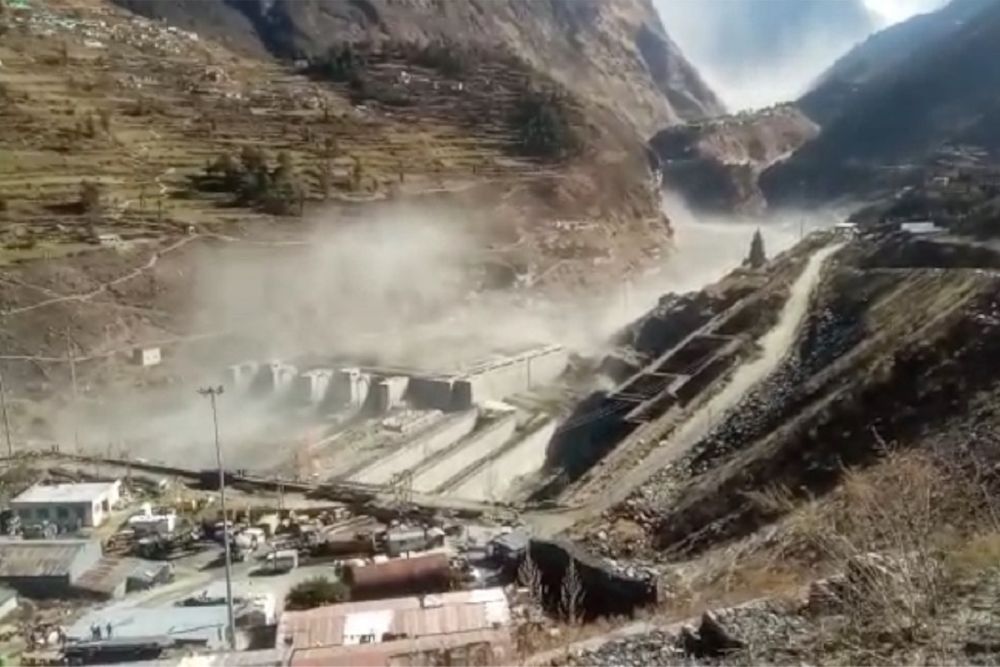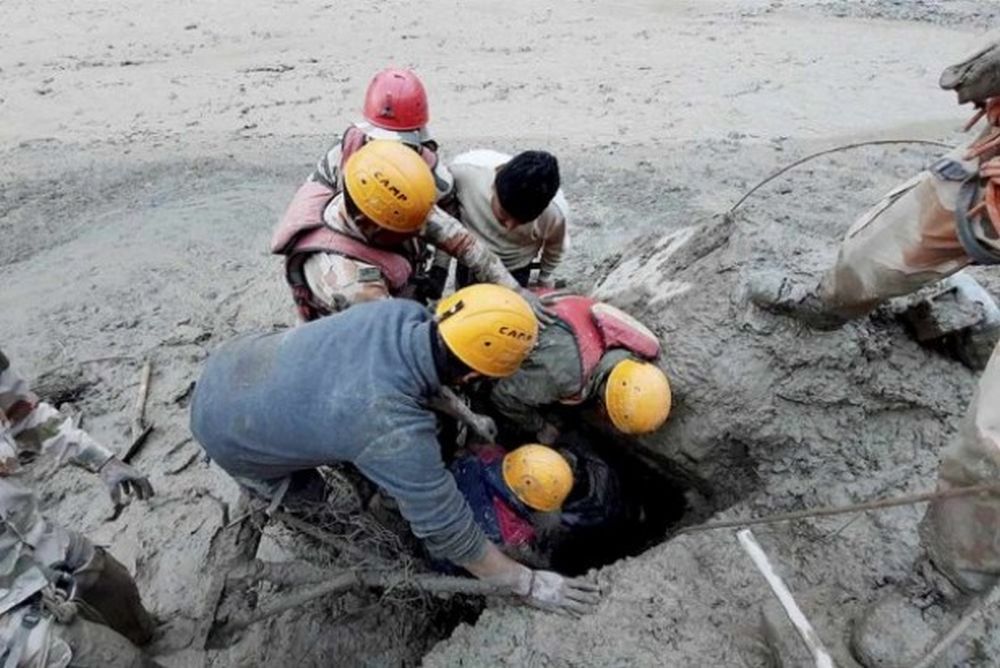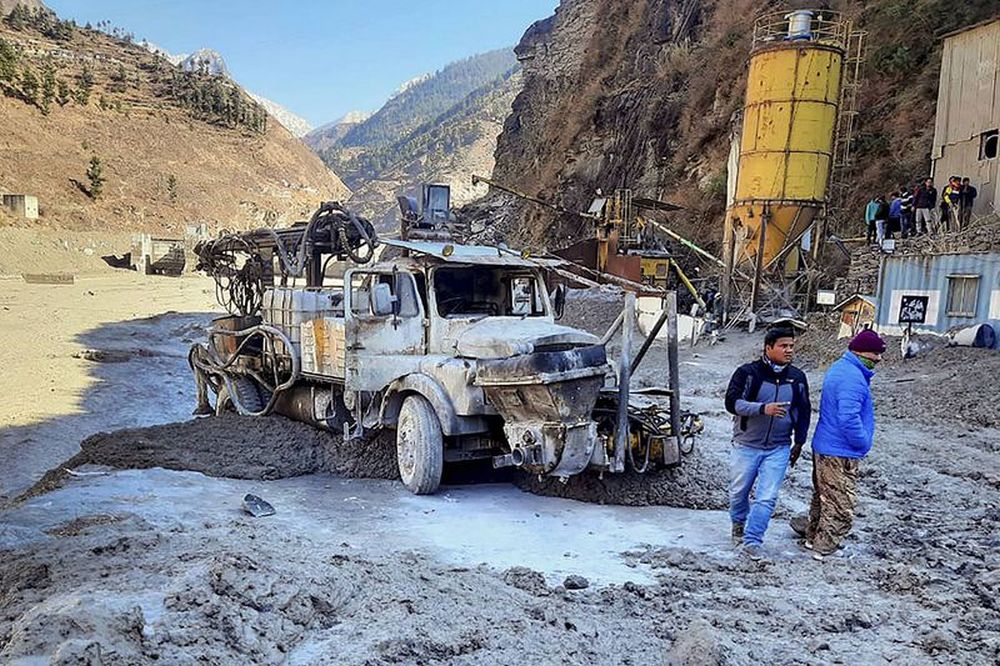Huge Flood after Uttarakhand Glacier Breaks Off – 32 Dead, 206 Missing
The melting of Himalayan glaciers has escalated worryingly since the beginning of the 21st century, mostly due to the rising global temperatures. Demonstrating the effects of this natural phenomenon, a portion of the Nanda Devi glacier broke off at Joshimath in Uttarakhand’s Chamoli district on Sunday, which triggered an avalanche and a huge flood in the Alaknanda River system.
The huge flood washed away hydroelectric stations and trapped more than 100 labourers who are feared to be dead. 14 people were killed, while 170 are still missing. The sudden flood in the middle of the day in the Dhauli Ganga, Rishi Ganga, and Alaknanda River – all knottily related tributaries of the Ganga – prompted widespread panic and large-scale devastation in the high mountain areas.

After a glacier breaks off in Uttarakhand on Sunday, it triggers an avalanche and a huge flood in the region | Image: IANS
Many villages were evacuated as floods destroyed five bridges, damaged homes, and the nearby NTPC power plant, and washed away a small hydropower project near Rishiganga. National and state disaster response teams and ITBP teams have been deployed. The Army has sent six columns and the Navy has positioned seven diving teams.
Twelve people entombed in an under-construction tunnel have been saved by an ITBP team. Nearly thirty people are trapped in a second tunnel, which is reportedly around 2.5 km long, and the rescue teams have been working through the night to rescue them. 14 bodies had been found so far. Medical teams have been rushed to affected locations. A 30-bed hospital was prepared at Joshimath and hospitals in Srinagar, Rishikesh, Jollygrant, and Dehradun are on standby.

Rescue teams trying to save stranded people in under-construction tunnel | Image: PTI
During his visit to Chamoli district on Sunday, Uttarakhand Chief Minister Trivendra Singh Rawat said that a team of scientific experts would work to detect the exact cause of this disaster. He also assured that rescue teams were doing their best to save the lives of the stranded and missing people.
Seismic activity or a buildup of water pressure could be the possible cause for glaciers to burst, but one particular concern is climate change. High temperatures coupled with less snowfall can accelerate melting, which causes water to rise to potentially dangerous levels. However, the exact cause for this particular incident hasn’t yet been determined.
The glacier collapse and flood disaster in an ecologically fragile part of Uttarakhand in the Indian Himalayas is a reminder of the hazards and vulnerability in high mountain regions. Video via @indiametdept
Details here: https://t.co/KZeWdxzmyO pic.twitter.com/R4JEbp7P6J— World Meteorological Organization (@WMO) February 9, 2021
He announced Rs. 4 lakh compensation for the family of those killed in the calamity. An extra Rs. 2 lakh will be given from the Prime Minister’s National Relief Fund, with Rs. 50,000 for those with serious injuries. Meanwhile, Prime Minister Narendra Modi has approved an amount of Rs. 2 lakh each for the next of kin of those who lost their lives in the flood.
Various videos and images uploaded on social media exhibited the massive burst of water tearing through a narrow valley below the power plant, destroying roads and bridges in its path. Authorities emptied two dams in order to stop the floodwaters from reaching Rishikesh and Haridwar, where people were not allowed to go near the Ganga riverbanks.

The site near damaged Dhauliganga hydropower project after the huge flood as Uttarakhand glacier breaks off | Image: PTI
The Uttar Pradesh government has put on a high alert for all the authorities in all districts on the banks of The Ganga and asked them to continuously monitor the water levels in the river after the glacier broke off in Joshimath.
This incident has reminded many of the massive flash floods and landslides that hit Uttarakhand’s Kedarnath in June 2013, killing over 5,700 people in one of the country’s worst natural disasters in the 2004 tsunami.
Scientists have analysed 40 years of satellite observations across Himalayan countries, which clearly indicates that climate change is rapidly melting glaciers in the region. It potentially threatens the water supply for hundreds of millions of people in these countries, including India; and poses greater threats of massive floods.
Update: February 10, 2021
In the recent developments, 32 bodies recovered, 206 persons (including 25-35 people stuck inside Tapovan tunnel) missing in the Uttarakhand glacier burst, according to the state government.
Update: February 11, 2021
As per the preliminary observations of experts regarding the Uttarakhand glacier flood disaster, the episode was most likely caused by a hanging glacier that slipped with rock and ice falling from 5,600 metres altitude owing to gravitational pull.
And the landslide that possibly triggered the debris flow, as seen in today’s #Sentinel2 acquisition pic.twitter.com/Z413jBenW2
— Sotiris Valkaniotis (@SotisValkan) February 10, 2021


